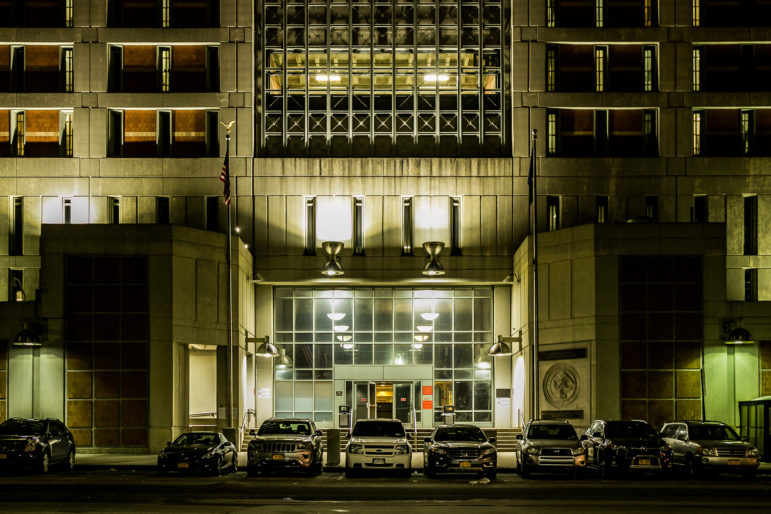
Adi Talwar
The Metropolitan Detention Center, Brooklyn is a federal detention facility that houses prisoners serving brief sentences, and prisoners with cases pending in the District Court for the Eastern District of New York.
Earlier this month, protesters and politicians rushed to the federal jail in Brooklyn after reports that people detained there were suffering through the frigid temperatures of a polar vortex with no heat, hot water, medicine, or visits with family or attorneys. The entire jail was on lockdown, which means people were held in their cells twenty-hours per day—a form of solitary confinement—for days and days, with no end in sight. Officials at the jail, the Metropolitan Detention Complex or MDC, alternately denied the reports and blamed an electric fire for the problems. They insisted they had submitted a “ticket” for the repair, but as family members gathered outside the jail pleading for help and held up signs for their incarcerated loved ones to see, and people inside banged on their wirecage windows for mercy, New York’s elected officials rightly insisted that was not good enough.
One state senator recounted on Twitter: “I spoke to a young brother who has asthma just like me. He told me, through tears, that he is having trouble breathing and he needs a nebulizer, a machine I’ve used hundreds of times in my life for relief. He has not been granted the device he needs to breathe or a medical visit, so he has been lying on the floor to try to breathe through the crack under the door.” This was an emergency.
Many of the human rights abuses taking place at MDC are actually common practices in New York State prisons and local jails. In fact, a state medical review board found that 50 people in state prisons may have died due to medical neglect in the past five years. Equally troubling, the lockdowns experienced by people at MDC are a standard disciplinary and administrative tool in prisons and jails. Better known as solitary confinement, on an average day up to 3,600 people are held in isolation in state prisons, and many more in local jails—including while detained pre-trial and legally innocent.
In 2015, the United States voted for, and the United Nations adopted, the Mandela Rules which prohibit any person from being held in solitary confinement beyond 15 days. Any time beyond 15 days is considered torture, and decades of social science research affirms this finding. Yet, in state prisons, people in solitary confinement are locked in small cells for 22 to 24 hours a day, with no access to meaningful human interaction, for weeks, months, years, and even decades. Imagine being stuck in an elevator or bathroom—not for minutes, but for years. They are denied access to commissary to purchase essential items like food to supplement the meager offerings they receive through a slot in their door. They are often denied visits which are critical to their well-being. Perhaps most senselessly, they are denied access to the kinds of programs that will address the underlying issues of any truly problematic behavior. They receive no educational or rehabilitative programming, and no transitional services to help them prepare for their return to society, increasing the rates of recidivism. In these conditions, people’s minds and spirits crumble. Those in pre-trial detention may decompensate beyond any ability to participate in their own defense, often pleading guilty regardless of innocence, at times in exchange for being released right back into the community.
The public imagines that people in solitary are there only for violent acts, but the reality is much different. The majority of people are in solitary for nonviolent offenses, at times for the most paltry of alleged offenses—and even for reporting abuse by staff. My 21-year-old son, who suffered from a severe mental illness, complained about physical and emotional abuse from corrections staff. In retaliation, he was falsely accused of fighting and thrown into solitary. Without access to his family and proper medication and therapy, his mental condition quickly deteriorated. He eventually took his own life while in his solitary cell. Tragically, between 2014 and 2016, 32 percent of all suicides in New York’s prisons occurred in solitary—deaths that could have been prevented.
Now, after an historic landslide election, New York finally has a key opportunity to end this torture by passing the Humane Alternatives to Long-Term (HALT) Solitary Confinement Act (A.2500 / S.1624). This legislation would establish more effective alternatives to solitary that emphasize greater socialization and rehabilitation, not isolation. In addition, it would limit solitary confinement to 15 consecutive days; ban it for special populations such as the young, elderly, mentally ill, physically disabled and pregnant women; restrict the criteria for placement in solitary; and enhance due-process protections before placement in solitary.
Get the best of City Limits news in your inbox.
Select any of our free weekly newsletters and stay informed on the latest policy-focused, independent news.
Governor Cuomo could have made these essential reforms to prisons and jails through executive actions years ago, but we always knew we would need the legislature’s backing to get this done. The HALT bill passed the Assembly last year and now we are optimistic that it will pass in both houses.
To be sure, solitary confinement is not the only human-rights abuse occurring in our prisons and jails. Brutality by staff, racist harassment, and repeated parole denials that leave people to age and die in a cage decades after their minimum sentences, are all urgent problems. However, ending long-term solitary confinement and replacing it with effective and humane programs that actually help people thrive and succeed will begin to dismantle the punishment paradigm that ails our society.
Douglas P. Van Zandt is the North Country Organizer for NY Campaign for Alternatives to Isolated Confinement (CAIC).








